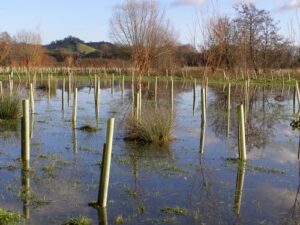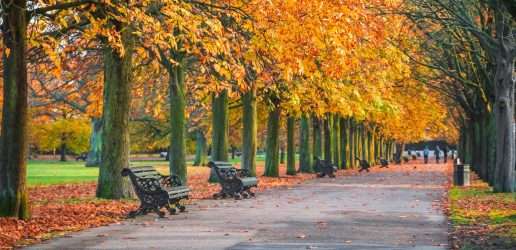
Recently published research conducted by Bangor University and Forest Research reviews the current state of knowledge on the role of forested lands for natural flood management (NFM) in the UK. Published in the WIREs Water journal, the review examines the existing evidence on the role that different types of forest cover play for NFM.
The authors specifically looked at four different woodland types: catchment, cross-slope, floodplain, and riparian, to determine the relative merits of each type and their effectiveness in mitigating flood risk. They found that while there is good understanding of the processes involved and some evidence that carefully planned and managed woodland can mitigate flood risk, the published data for this evidence base is somewhat sparse. This may be either due to the long timescales needed to conduct comprehensive studies or the relative infancy of the research on NFM.

Matt Cooper, the lead author and KESS 2 East PhD candidate at Bangor University, explains:
“I think that this is a very interesting study to answer what seems to be a very simple question, “if a valley has trees up the sides, will the stream at the bottom have a lesser flow following heavy rainfall than if there are no trees?”. The intuitive answer is of course “yes”, but at the moment there is very little quantitative evidence for this for large floods, as our review shows. Natural flood management is gaining a lot of traction and increasing the forest cover in our catchments is one of the strategies for mitigating flood risk. Our review indicates that more work is needed to better quantify the effect that different woodland types and placements can have on catchment flood peaks.”
Dr Sopan Patil, Lecturer in Catchment Modelling at the School of Environmental and Natural Sciences and co-author of the paper, adds:
“Flooding is a complex issue and affects us all in the UK. Although it has been suggested that NFM techniques, such as floodplain restoration, leaky barriers, woodland creation, and runoff management, can be used as cost-effective supplements to our existing flood defence infrastructure, their effectiveness for mitigating flood risk is not fully understood. Our review highlights the need for more research on using woodlands as a NFM strategy. This is especially important for the UK, as policymakers are increasingly looking towards nature-based solutions to mitigate the potential impacts of climate change.”
Dr Tom Nisbet, Head of Physical Environment Science in Forest Research, commented:
“Climate change is expected to lead to an increased frequency of flooding, with some evidence that this is already happening. Trees and woodlands have an important role to play in helping society adapt to a warmer world, including in managing flood risk. This review highlights the need for further advances in understanding and modelling to better guide future planting and woodland management for flood alleviation.”
Matt is funded by Forest Research and KESS 2 East; a pan-Wales higher level skills initiative led by Bangor University on behalf of the Higher Education sector in Wales. It is part funded by the Welsh Government’s European Social Fund (ESF) convergence programme for East Wales.
Recent News
View All news
Seventeen coniferous tree species show early promise for future commercial timber production in the UK
Researchers have set up a network of nine large scale experiments across the UK to test the suitability of 17 tree species as potential alternatives for future commercial timber production.
Forest Research are looking for people involved in the harvesting, processing, transport, import, or trade of firewood in Scotland to complete an important survey.

New guide to help local authorities conduct a people survey on the social value of their treescapes
A new step-by-step guide to help local authorities, charities and civic societies carry out a people survey to understand social and cultural values related to trees in their area, is now available.

Seventeen coniferous tree species show early promise for future commercial timber production in the UK
Researchers have set up a network of nine large scale experiments across the UK to test the suitability of 17 tree species as potential alternatives for future commercial timber production.
Forest Research are looking for people involved in the harvesting, processing, transport, import, or trade of firewood in Scotland to complete an important survey.

New guide to help local authorities conduct a people survey on the social value of their treescapes
A new step-by-step guide to help local authorities, charities and civic societies carry out a people survey to understand social and cultural values related to trees in their area, is now available.

